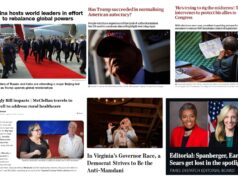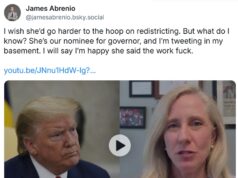Back in 2022, Molly Ball wrote about the new governor of Virginia, Glenn Youngkin, and…yeah, it was a hot mess (as Kindler wrote at the time, it was a “pathetic puff piece,” “fawning hagiography,” whitewashing, etc.). Now, Molly Ball is baaack, this time writing about the likely *next* governor of Virginia, Abigail Spanberger (standard disclaimer: take nothing for granted, don’t get overconfident, etc.).
The good news is that this article, in the Wall Street Journal, couldn’t possibly be as horrible as the 2022 piece on Youngkin. And, in fact, it isn’t even CLOSE to as bad as the Youngkin article cringe-inducing disaster. But it’s still not great – kind of a mixed bag, with some really bad stuff, mixed stuff, and decent stuff in there. See below for a few examples of each of those.
- Probably the worst, most ridiculous part of the article are the headline (“In Virginia’s Governor Race, a Democrat Strives to Be the Anti-Mamdani”) and subheader (“Abigail Spanberger is seen as a potential moderate face for her struggling party”), neither of which presumably are the author’s fault, as they’re probably written by Wall Street Journal editors. Still, no matter who came up with this framing, it’s just absurd – clickbait at best – to claim that someone who first was elected in 2018, loooong before almost anyone had ever heard of Mamdani, and who has been very consistent in her public “branding,” etc. for years, is suddenly putting herself out there as the “anti-Mamdani.” Because the fact is, Spanberger hasn’t particularly changed her political “persona” since she entered the US House in 2019 (e.g., per Progressive Punch, in 2019-2020 she ranked as the 207th most-progressive U.S. Representative, with an “F” progressive score relative to district tilt; in 2023-2024, she ranked #190, again with an “F” progressive score relative to district tilt). Now, you can decide for yourself if you find that appealing or not, but the point is, she hasn’t been similar ideologically to Mamdani since 2019, so the idea that she’s suddenly – now that she’s running for governor of Virginia, and now that Mamdani has achieved national prominence and likely will be the next mayor of NY City – morphed into an anti-Mamdani, or really that she’s changed significantly in any way. Because she really hasn’t. So again, this just seems like brain-dead clickbait by the Wall Street Journal – and it will probably work, honestly, as people love this kind of “framing,” even if it’s total bullshi*.
- Also, the fact is, NY City is really not comparable to Virginia politically, so why of all things write an article setting it up as between the Democratic nominee in NY City and the Democratic nominee in Virginia? Because, again, they’re very different places, with very different electorates and very different dynamics (e.g., Mamdani is running against slimeball Andrew Cuomo and corrupt Eric Adams – both of whom are officially Democrats, even though they aren’t the Democratic nominee; Spanberger is running against a far-right Republlican). It seems like these are things that should be noted, right up front, before jumping into the Mamdani vs. Spanberger framing, no?
- As for the subhead, “Spanberger is seen as a potential moderate face for her struggling party” (followed up in the first paragraph with the line, “Her bigger test may be taking back her own party.”), there’s a lot to unpack there, but basically I’d argue it’s a big reach – or at least I’d like to see factual evidence for these claims. I mean, to the extent Democrats are “struggling,” it seems to me that the main problem is Democrats control zero branches of the federal government, which means they have minimal power to stop Trump’s anti-government, anti-science, anti-rule-of-law, anti-constitution, anti-civil-liberties, etc. onslaught. So sure, the Democratic Party is “struggling,” as is our democracy, but to make the leap from there to the likely future governor of one state (Virginia) being the one to save Democrats, “take back her party,” blah blah blah, just seems absurd, at least to me. Also, there are many implicit assumptions and values embodied in this framing, all of which just seem to be assumed as true – such as that Democrats’ problem is not being “moderate” enough,” or that the party needs to be “taken back” from…what, non-moderates, I guess? So sure, if Molly Ball or whoever wants to make that argument, they can certainly do so, but at least be clear about the argument you’r making, spell it out, then provide some evidence to back it up. But…nope, we get none of that here, and that alone makes it hard to take the article seriously.
- This is a decent sentence, at least: “Republicans are privately pessimistic about Earle-Sears, an awkward candidate who has churned through campaign staff and made few efforts to appeal to the middle of the electorate.” Although even here, it should also have been noted that Earle-Sears isn’t in any way/shape/form a moderate Republican, but instead is a far-right Republican with a history of extreme, loony comments and actions over the years. But god forbid a reporter say stuff like that – they might lose their precious “access,” after all! Ugh.
- Finally, I think Bob Holsworth’s quote is partly accurate, but with one glaring red flag: “Spanberger, he said, is playing it safe, seeking not to disrupt a dynamic that favors her. But it’s fair to question whether her cautious, technocratic campaign is best suited to what’s manifestly an age of extremes, with demoralized Democrats enraged at party leaders they see as not putting up enough of a fight.” The part that’s accurate is that Spanberger *does* appear to be playing it safe, given her polling lead and the dynamic of Virginia going opposite the unpopular president in the White House. The part that’s a glaring red flag, of course, is the false equivalence/”both-sides” b.s. about “an age of extremes,” when in fact only ONE party – Trump’s MAGA GOP – has gone “extreme,” waging war on American democracy, while the Democratic Party remains a pretty typical small-d democratic party, similar (or even more conservative) than analogous parties in other “advanced, industrialized” countries (Canada, the UK, France, Germany, etc.). Of course, that would take another sentence for the author to point out, but…nope, can’t do that, apparently, because gotta stick with the “both-sides”/false equivalence bullshi* – it’s what the “mainstream media” does, after all. #FAIL
Bottom line: This article sucked in many ways, but it could have sucked a lot worse, given the initial framing and the author’s definitely-not-good track record in covering Virginia politics. And these days, given how awful the “mainstream media” is, I guess that’s the best we can expect? Sad.
P.S. An astute commenter just reminded me of the fact that TRUMP is the one who’s acting like a “socialist” – heavy government involvement in private industry, including buying stakes in Intel, etc.; interference in free markets (e.g., tariffs!); higher taxes (again, tariffs!). So why doesn’t Molly Ball write an article framed as whether Winsome Earle-Sears agrees with Trump’s socialism, or whether she’s actually a capitalist or what? Would the media EVER do something like that with Republicans, or do they only do it with Democrats? (I think we know the answer to that rhetorical question)




![Video: VA11 Dem Nominee James Walkinshaw Says “I’m excited to vote in November as well, but we’ve [also] got to be excited to vote on September 9th”](https://bluevirginia.us/wp-content/uploads/2025/08/walknshawwhite-238x178.jpg)









